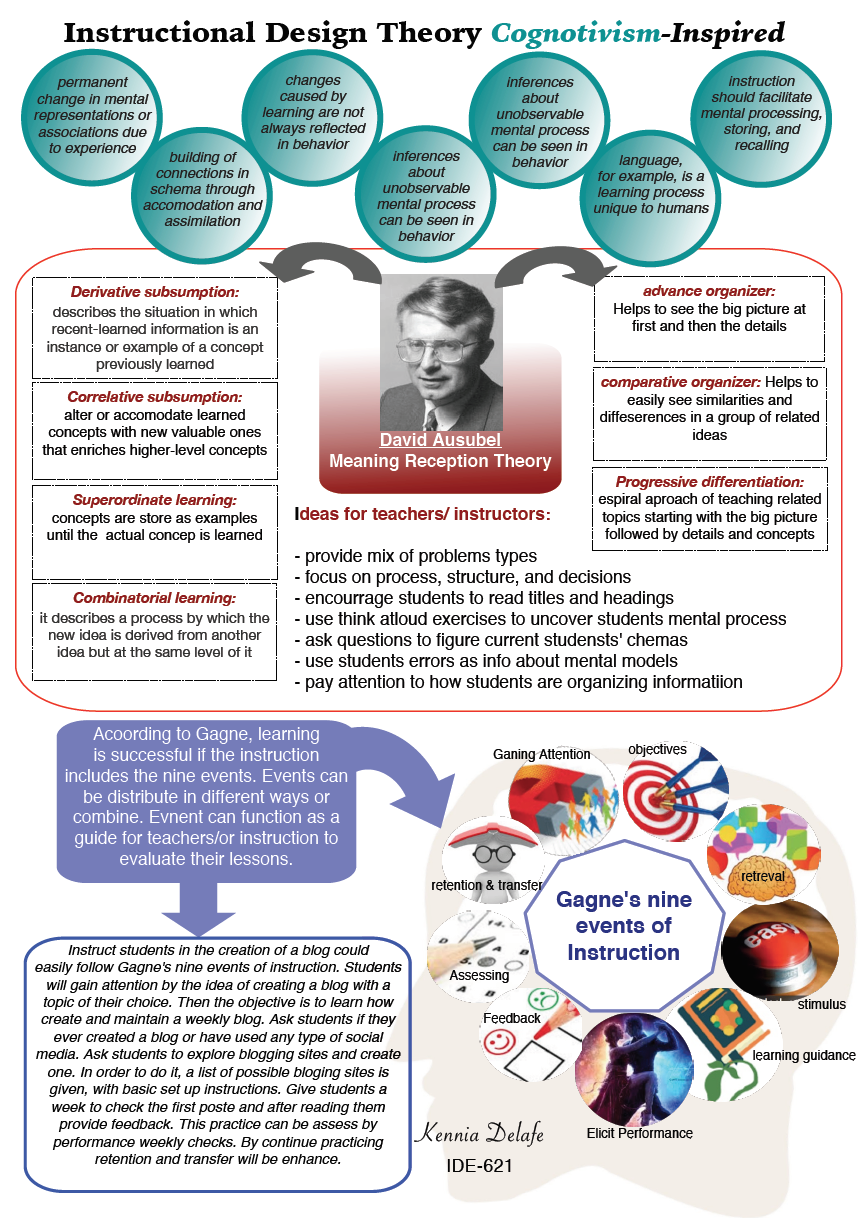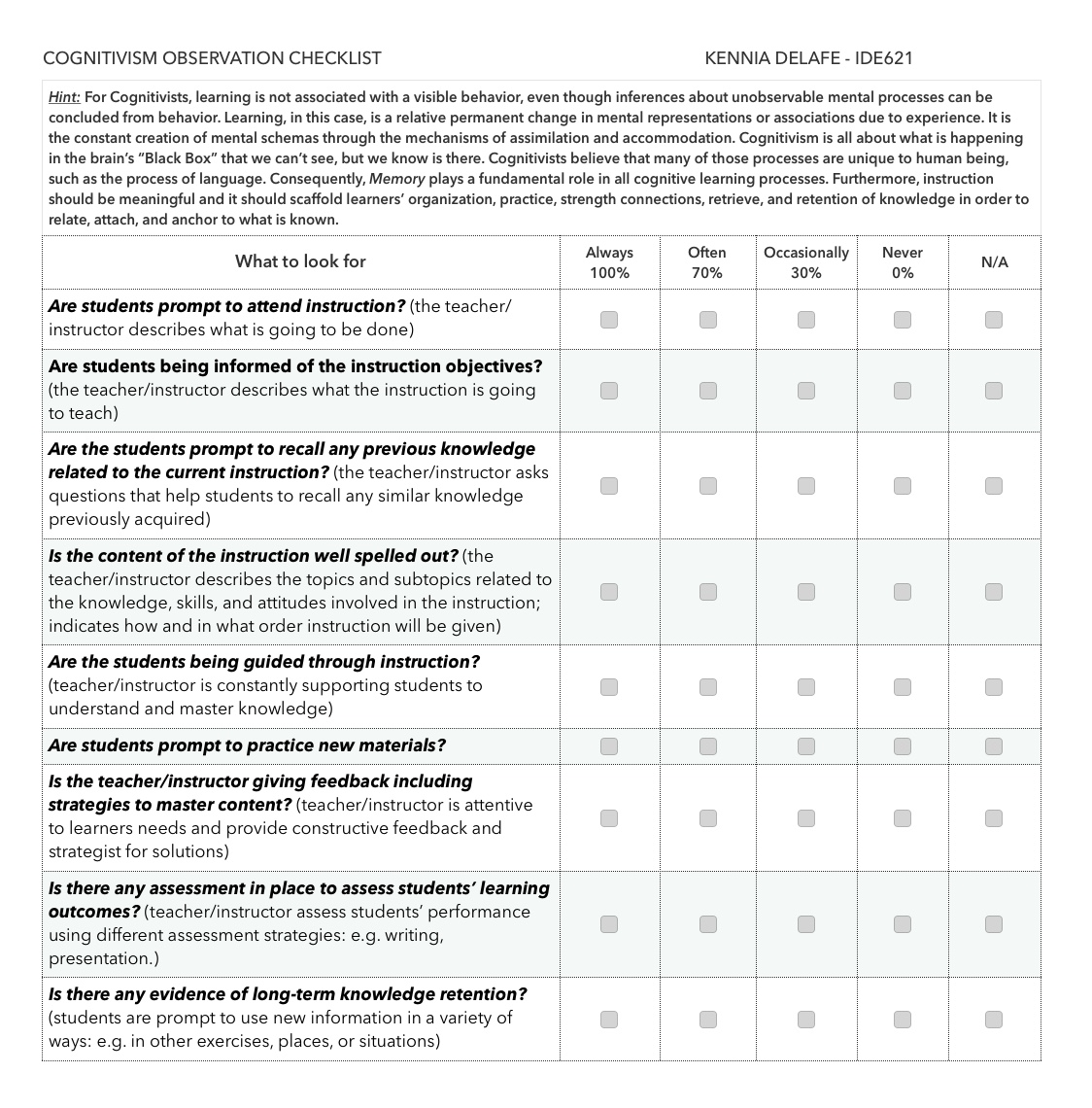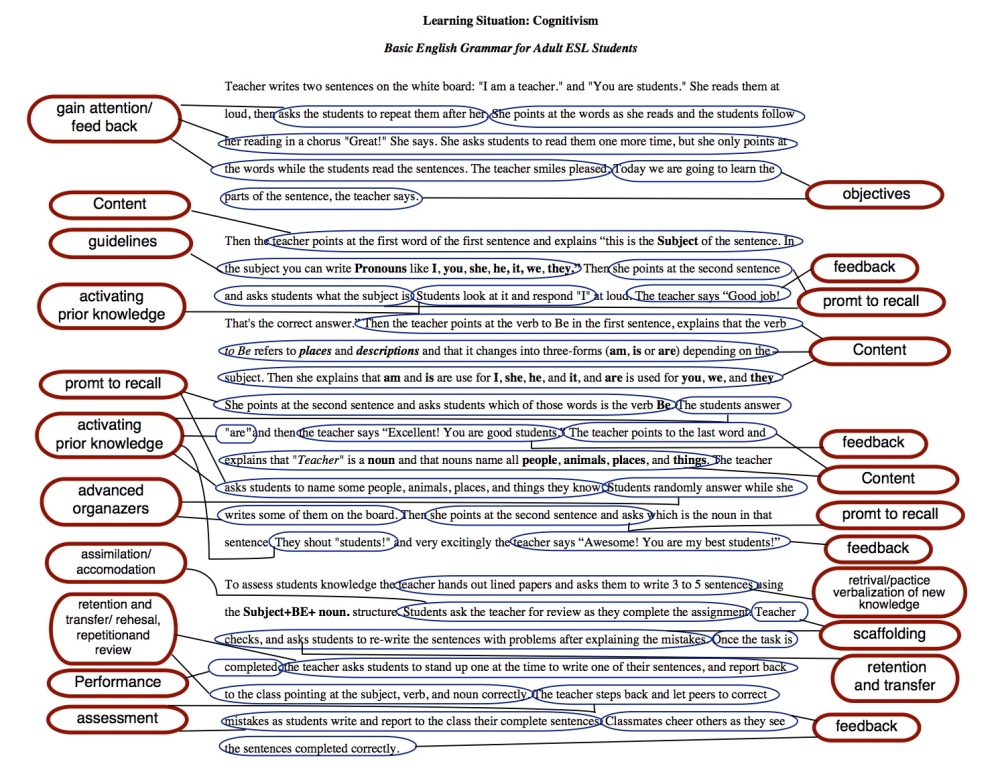What is Cognitivism Learning Theory?
According to Cognitivism Theory, learning is a relatively permanent change in mental structures (schema) as a result of experience.
Page Content
Infographic 1
Infographic 2
Learning Situation
Observation Checklist
Reflection
Infographic 1
Click on the following link to access to the pdf file: Infographic-Cognitivism1

…”Cognitive psychology derived its name from the Latin cognoscere, referring to knowledge and information. Thus cognitive psychology is an information-processing psychology derived in part from earlier traditions of the investigation of thought and problem-solving.”
retrieved from: https://en.wikipedia.org/wiki/Cognitivism_(psychology)
The Growth of Knowledge YouTube Video. Click on the following link: https://www.youtube.com/watch?v=8nz2dtv–ok&feature=youtu.be
Infographic 2
Click on the following link to access to the pdf file: Instructional Design Theories Based on Cognitivism

Examples of Cognitivism Theory in practice
School Setting:
PBSkids.org and Cognitive Fun! are good examples of applied cognitive learning theory. These web pages contain many different exercises and tests to build mental schemas while playing. Here are the links: PBSkids and Cognitive Fun!
Job Setting:
How learning Theories can Help Train Employees is an article written by an anonymous student. It presents interesting ideas of how Cognitive Learning Theory can enhance employees’ preparation for given job performance, and how HR representatives can use it for their new-employees training.
Reference: Essays, UK. (November 2013). How Learning Theories Can Help Train Employees. Retrieved from https://www.ukessays.com/essays/education/learning-theories-can-help-train-employees-education-essay.php?vref=1
Learning Situation
Title: Basic English Grammar for Adult ESL Students
The teacher writes two sentences on the whiteboard: “I am a teacher.” and “You are students.” She reads them at loud, then asks the students to repeat them after her. She points at the words as she reads and the students follow her reading at loud. “Great!” She says. She asks students to read them one more time, but she only points at the words while the students read the sentences. The teacher smiles pleased. Today, we are going to learn the basic structure of a sentence, the teacher says.
The teacher points at the first word of the first sentence and explains “this is the Subject of the sentence. In the subject you can write Pronouns like I, you, she, he, it, we, they. Then she points at the second sentence and asks students what the subject is. Students look at it and respond ‘I’ at loud. The teacher says That’s the correct answer!
Then the teacher points at the verb To Be in the first sentence and explains that it refers to places and descriptions and that it changes into three-forms (am, is or are) depending on the subject. Then she explains that (am) is used for the subject I, (is) is used for the subjects she, he, and it, and (are) is used for you, we, and they.
She points at the second sentence and asks students which of those words is the verb Be. The students answer, ‘are’ and then the teacher says “Excellent! You are good students.” The teacher points to the last word and explains that “Teacher” is a noun and that nouns name all people, animals, places, and things. The teacher asks students to name some people, animals, places, and things they know. Students randomly answer while she writes some of them on the board. Then she points at the second sentence and asks which is the noun in that sentence. They shout “students!” and very excitingly the teacher says “Awesome! You are my best students!”
To assess students knowledge, the teacher hands out outlined papers and asks them to write 3 to 5 sentences using the Subject + BE + noun structure. Students ask the teacher for review as they complete the assignment. Teacher checks, and asks students to re-write the sentences after explaining and correcting mistakes. Once tasks are completed, the teacher asks students to stand up one at the time to write one of their sentences on the boar, and report back to the class pointing at the subject, verb, and noun. The teacher steps back and lets peers correct mistakes as students write and report to class their completed sentences. Classmates cheer others as they see the sentences completed correctly.
Click on the following link to access to the pdf file of the analysis of the Learning Situation: CaseStudy-Cognitivism.pdf
Observation Checklist
Click on the following link to access to the pdf file: CognitivismObservationChecklist.pdf

Self-Reflection
Cognitivism theory is also fascinating because I am usually intrigued by the way people know things and how they can remember and connect old ideas with new ones making them very originals. From being an ESL learner myself and a non-traditional student, I have had the opportunity to experience many ways of learning guided by different professors’ teaching strategies. I have struggled a lot to get to this point. It has been a constant assimilation of new information connecting it to what I had from previous studies or learning it from scratch, training myself to disregard what I don’t need or is irrelevant and save what it is essential, and most importantly, realize how my knowledge and skills have increased so far over the years. But the question is, is it me doing all this or it is the way our brain is conditioned to function?
Regardless, It always has captivated me the way the unconscious works connecting all the dots for us to learn. The “Black Box” functions extremely and efficiently without permission, motivated by the idea many instructors train us to learn. This concept is nothing new; I believe everyone experiences this phenomenon. The problem is if I feel like cognitivism theory has all the instruments to indeed facilitate learning as a whole instead of as a one, meaningful, but a piece. I still believe that students should be exposed to experience learning through all the possibilities that it could have. Teaching in a way that is limited to organizing ideas to provide storage and retrieval of information continue lacking the human need of connecting with others.
I can see the advantages of knowing how the brain functions to acquire information and what teaching strategies are used to promote better long-term memory and retrieval of information in any training setting. I am in favor of continuing adopting many more of those approaches, but I can’t say that I define my teaching as cognitive. It is much more than that.
